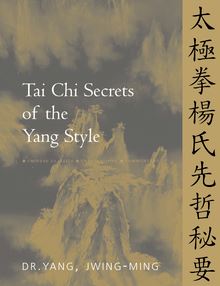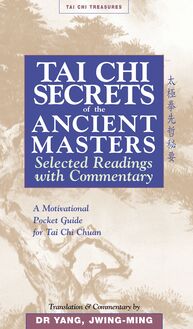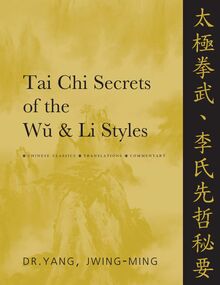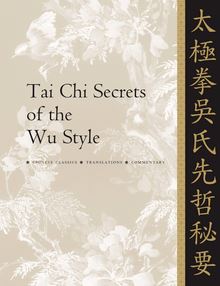-
 Univers
Univers
-
 Ebooks
Ebooks
-
 Livres audio
Livres audio
-
 Presse
Presse
-
 Podcasts
Podcasts
-
 BD
BD
-
 Documents
Documents
-
- Cours
- Révisions
- Ressources pédagogiques
- Sciences de l’éducation
- Manuels scolaires
- Langues
- Travaux de classe
- Annales de BEP
- Etudes supérieures
- Maternelle et primaire
- Fiches de lecture
- Orientation scolaire
- Méthodologie
- Corrigés de devoir
- Annales d’examens et concours
- Annales du bac
- Annales du brevet
- Rapports de stage
La lecture à portée de main
Vous pourrez modifier la taille du texte de cet ouvrage
Découvre YouScribe en t'inscrivant gratuitement
Je m'inscrisDécouvre YouScribe en t'inscrivant gratuitement
Je m'inscrisEn savoir plus
Vous pourrez modifier la taille du texte de cet ouvrage
En savoir plus

Description
Since ancient times Tai Chi Chuan has been practiced as a holistic mind/body fitness system, bringing immense benefits for practitioners in health, longevity, relaxation, and concentration. Tai Chi Chuan was also practiced as an effective and deadly martial art.
Because of this, the ancient masters rarely disclosed their secrets, guarding them as closely as they would military secrets. They preserved their profound insights in obscure songs, poems, and classics, revealing only to those they considered trustworthy and ready for such knowledge. That is, until this century.
Now, you can reap the benefits of centuries of wisdom and practical experience to deepen and refine your Tai Chi Chuan. Discover ways to reach the essence of your Form and take your Push Hands to higher levels. Dr. Yang has translated these classics from the original Chinese, and has written commentaries to make them more accessible to contemporary minds. Tai Chi Secrets of the Wu Style is an invaluable resource for students who seek true understanding of their art.
- Useful for any style of Tai Chi Chuan.
- Sound, practical advice for any martial art.
- Key points for incorporating the teachings into your practice.
Sujets
Informations
| Publié par | YMAA Publication Center |
| Date de parution | 16 août 2020 |
| Nombre de lectures | 0 |
| EAN13 | 9781594396977 |
| Langue | English |
| Poids de l'ouvrage | 1 Mo |
Informations légales : prix de location à la page 0,0500€. Cette information est donnée uniquement à titre indicatif conformément à la législation en vigueur.
Extrait
TAI CHI SECRETS OF THE WU STYLE
Tai Chi Secrets of the Wu Style
Chinese Classics Translations Commentary
by Dr. Yang, Jwing-Ming
YMAA Publication Center
Wolfeboro, NH USA
YMAA Publication Center
Main Office:
PO Box 480
Wolfeboro, NH, 03894 USA
800-669-8892 info@ymaa.com www.ymaa.com
Copyright 2002 by Yang, Jwing-Ming
Edited by James O Leary
Cover design by Katya Popova
ISBN 13: 978-1-886969-17-9
ISBN 10: 1-886969-17-5
All rights reserved including the right of reproduction in whole or in part in any form.
Publisher s Cataloging in Publication
(Prepared by Quality Books Inc.)
Yang, Jwing-Ming, 1946-
Tai chi secrets of the Wu style : Chinese classics, translations, commentary / by Yang, Jwing-Ming. - 1st ed.
p. cm.
Includes index.
Chiefly in English; some text in Chinese.
LCCN: 2002101587
ISBN: 1-886969-17-5
1. Tai chi. I. Title.
GV504.Y36 2002 613.7 148
QBI02-200165
Contents
Foreword by Nick Gracenin
About the Author
Introduction
About Wu Family and Wu, Gong-Cao
Acknowledgments
The Total Thesis of Taijiquan
The Important Meaning of Taijiquan Thirteen Postures
The Detailed Interpretation of Five Elements
The Secrets of Eight Techniques
The Interpretation of Slow and Without Force
Central Equilibrium
Insubstantiality Leading the Head Upward
Feeling and Sensing
Listening Jin
Questions and Answers
Insubstantial and Substantial
Gauging the Opponent
Knowing the Opportunity
Weighting
Double Weighting
Giving Up Self and Following Opponent
Drumming and Vibrating
Foundation
Teaching and Learning
Appendix A: The Thesis of Taijiquan, by Xiang, Kai-Ran
Appendix B. Translation and Glossary of Chinese Terms
Index
Foreword
The content of Chinese Wushu ( )(martial arts) is vast and highly diverse. Various schools and styles of Wushu are often categorized into the internal and external varieties. Taijiquan is one of the major divisions of the internal school. Within Taijiquan there are dozens of sub-categories based on the teachings of one Master or a family with generations of experts. The origins of some forms are well documented and reference material is readily available. The Chen ( ) and Yang ( ) styles which precede the other forms historically have dozens of videotapes, vcd publications, and printed materials available in several languages. Of the five primary family styles of Taijiquan, the Wu style ( )is not as widely practiced in the West as the other forms. Noted for compact structure, gentle and fluid movements, and beautiful balancing techniques, Wu style Taijiquan can provide a solid foundation in many areas: fitness, healing, recreation, personal development and effective self-defense training. The practitioner must have some clear understanding of the basic tenets of the art in order to develop real skills, hence the necessity for the transmission of the essential information by the true Masters of the art. Unfortunately, published material on this style is especially difficult to find.
Tai Chi Secrets of Wu Style by Dr. Yang, Jwing-Ming promises to be a major source of information on this beautiful and useful martial art. In this work, Dr. Yang has included the English translation as well as the original Chinese text, enabling us to examine the material from both language perspectives. Although I have studied martial arts more than thirty years, my limited experience with Wu style leads me to welcome the chance to explore the essence of Wu, Jian-Quan s ( )teaching. For many years Dr. Yang s work has informed and inspired martial artists around the world. His translations and insightful commentary afford us the opportunity to delve deeply into the theories and philosophies of prior generations. The Chinese martial arts practitioners of the West owe a great debt of gratitude to Dr. Yang for this and his many other contributions to the development and promotion of our art. There is a famous saying among Chinese Wushu people which begins: Shifu Ling Jin men. ( ) (The teacher leads into the door.) Dr. Yang, Jwing-Ming has opened many doors for us. This portal to the essence of the Wu style Taijiquan traditions provides access to hitherto unavailable information, yet again expanding the boundaries of the Chinese martial world.
Nick Gracenin
July 7, 2001
About the Author
Dr. Yang, Jwing-Ming, Ph.D .
Dr. Yang, Jwing-Ming was born on August 11th, 1946, in Xinzhu Xian ( ), Taiwan ( ), Republic of China ( ).He started his Wushu ( )(Gongfu or Kung Fu, )training at the age of fifteen under the Shaolin White Crane (Bai He, ) Master Cheng, Gin-Gsao ( ).Master Cheng originally learned Taizuquan ( )from his grandfather when he was a child. When Master Cheng was fifteen years old, he started learning White Crane from Master Jin, Shao-Feng ( ), and followed him for twenty-three years until Master Jin s death.
In thirteen years of study (1961-1974 A.D .) under Master Cheng, Dr. Yang became an expert in the White Crane Style of Chinese martial arts, which includes both the use of barehands and of various weapons such as saber, staff, spear, trident, two short rods, and many other weapons. With the same master he also studied White Crane Qigong ( ), Qin Na (or Chin Na, ), Tui Na ( )and Dian Xue massages ( )and herbal treatment.
At the age of sixteen, Dr. Yang began the study of Yang Style Taijiquan ( ) under Master Kao Tao ( ). After learning from Master Kao, Dr. Yang continued his study and research of Taijiquan with several masters and senior practitioners such as Master Li, Mao-Ching ( ) and Mr. Wilson Chen ( ) in Taipei ( ). Master Li learned his Taijiquan from the well-known Master Han, Ching-Tang ( ), and Mr. Chen learned his Taijiquan from Master Zhang, Xiang-San ( ). Dr. Yang has mastered the Taiji barehand sequence, pushing hands, the two-man fighting sequence, Taiji sword, Taiji saber, and Taiji Qigong.
When Dr. Yang was eighteen years old he entered Tamkang College ( ) in Taipei Xian to study Physics. In college he began the study of traditional Shaolin Long Fist (Changquan or Chang Chuan, ) with Master Li, Mao-Ching at the Tamkang College Guoshu Club ( )(1964-1968 A.D. ), and eventually became an assistant instructor under Master Li. In 1971 he completed his M.S. degree in Physics at the National Taiwan University ( ), and then served in the Chinese Air Force from 1971 to 1972. In the service, Dr. Yang taught Physics at the Junior Academy of the Chinese Air Force ( ) while also teaching Wushu. After being honorably discharged in 1972, he returned to Tamkang College to teach Physics and resumed study under Master Li, Mao-Ching. From Master Li, Dr. Yang learned Northern Style Wushu, which includes both barehand (especially kicking) techniques and numerous weapons.
In 1974, Dr. Yang came to the United States to study Mechanical Engineering at Purdue University. At the request of a few students, Dr. Yang began to teach Gongfu (Kung Fu), which resulted in the foundation of the Purdue University Chinese Kung Fu Research Club in the spring of 1975. While at Purdue, Dr. Yang also taught college-credited courses in Taijiquan. In May of 1978 he was awarded a Ph.D. in Mechanical Engineering by Purdue.
In 1980, Dr. Yang moved to Houston to work for Texas Instruments. While in Houston he founded Yang s Shaolin Kung Fu Academy, which was eventually taken over by his disciple Mr. Jeffery Bolt after moving to Boston in 1982. Dr. Yang founded Yang s Martial Arts Academy (YMAA) in Boston on October 1, 1982.
In January of 1984 he gave up his engineering career to devote more time to research, writing, and teaching. In March of 1986 he purchased property in the Jamaica Plain area of Boston to be used as the headquarters of the new organization, Yang s Martial Arts Association. The organization has continued to expand, and, as of July 1st 1989, YMAA has become just one division of Yang s Oriental Arts Association, Inc. (YOAA, Inc.).
In summary, Dr. Yang has been involved in Chinese Wushu since 1961. During this time, he has spent thirteen years learning Shaolin White Crane (Bai He), Shaolin Long Fist (Changquan), and Taijiquan. Dr. Yang has more than thirty-three years of instructional experience: seven years in Taiwan, five years at Purdue University, two years in Houston, Texas, and nineteen years in Boston, Massachusetts.
In addition, Dr. Yang has also been invited to offer seminars around the world to share his knowledge of Chinese martial arts and Qigong. The countries he has visited include Argentina, Austria, Barbados, Belgium, Bermuda, Botswana, Canada, Chile, England, France, Germany, Holland, Hungary, Ireland, Italy, Latvia, Mexico, Poland, Portugal, Saudi Arabia, Spain, South Africa, Switzerland, and Venezuela.
Since 1986, YMAA has become an international organization, which currently includes 52 schools located in Argentina, Belgium, Canada, Chile, England, France, Holland, Hungary, Iran, Ireland, Italy, Poland, Portugal, South Africa, Spain, Venezuela and the United States. Many of Dr. Yang s books and videotapes have been translated into languages such as French, Italian, Spanish, Polish, Czech, Bulgarian, Russian, Hungarian, and Persian.
Dr. Yang has published twenty-nine other volumes on the martial arts and Qigong :
1. Shaolin Chin Na; Unique Publications, Inc., 1980.
2. Shaolin Long Fist Kung Fu; Unique Publications, Inc., 1981.
3. Yang Style Tai Chi Chuan; Unique Publications, Inc., 1981.
4. Introduction to Ancient Chinese Weapons; Unique Publications, Inc., 1985.
5. Qigong for Health and Martial Arts; YMAA Publication Center, 1985.
6. Northern Shaolin Sword; YMAA Publication Center, 1985.
7. Tai Chi Theory and Martial Power; YMAA Publication Center, 1986.
8. Tai Chi Chuan Martial Applications; YMAA Publication Center, 1986.
9. Analysis of Shaolin Chin Na; YMAA Publication Center, 1987.
10. Eight Simple Qigong Exercises for Health; YMAA Publication Center, 1988.
11. The Root of Chinese Qigong - The S
-
 Univers
Univers
-
 Ebooks
Ebooks
-
 Livres audio
Livres audio
-
 Presse
Presse
-
 Podcasts
Podcasts
-
 BD
BD
-
 Documents
Documents
-
Jeunesse
-
Littérature
-
Ressources professionnelles
-
Santé et bien-être
-
Savoirs
-
Education
-
Loisirs et hobbies
-
Art, musique et cinéma
-
Actualité et débat de société
-
Jeunesse
-
Littérature
-
Ressources professionnelles
-
Santé et bien-être
-
Savoirs
-
Education
-
Loisirs et hobbies
-
Art, musique et cinéma
-
Actualité et débat de société
-
Actualités
-
Lifestyle
-
Presse jeunesse
-
Presse professionnelle
-
Pratique
-
Presse sportive
-
Presse internationale
-
Culture & Médias
-
Action et Aventures
-
Science-fiction et Fantasy
-
Société
-
Jeunesse
-
Littérature
-
Ressources professionnelles
-
Santé et bien-être
-
Savoirs
-
Education
-
Loisirs et hobbies
-
Art, musique et cinéma
-
Actualité et débat de société
- Cours
- Révisions
- Ressources pédagogiques
- Sciences de l’éducation
- Manuels scolaires
- Langues
- Travaux de classe
- Annales de BEP
- Etudes supérieures
- Maternelle et primaire
- Fiches de lecture
- Orientation scolaire
- Méthodologie
- Corrigés de devoir
- Annales d’examens et concours
- Annales du bac
- Annales du brevet
- Rapports de stage









